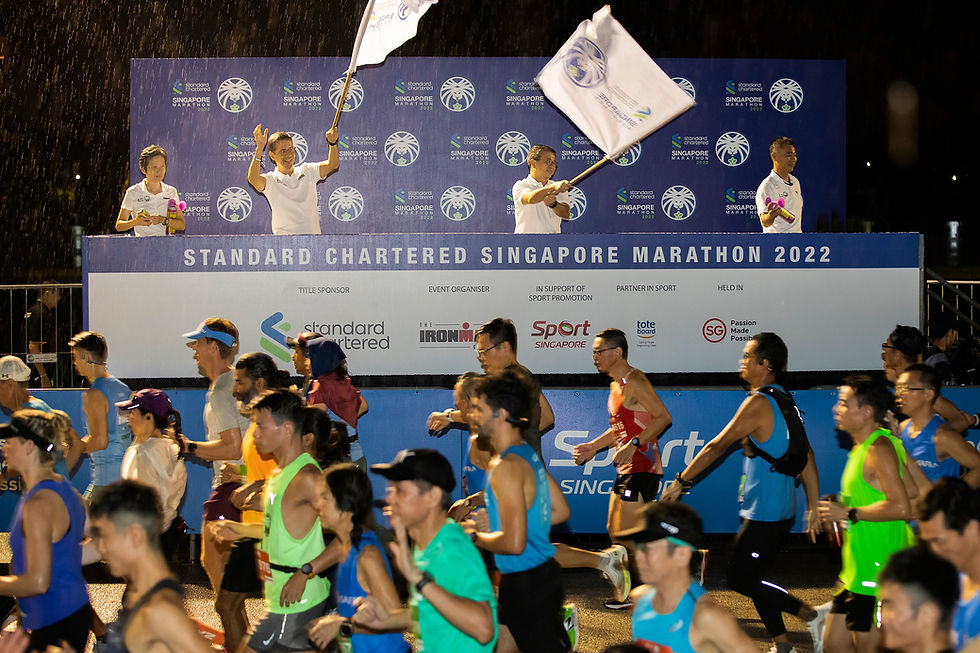Inside Standard Chartered Singapore Marathon (1): Measuring the Singapore Marathon Race Course
- John Yeong

- Nov 15, 2023
- 4 min read
Updated: Nov 17, 2023
SportPlus.sg joins Standard Chartered Singapore Marathon behind-the-scenes to debunk certain myths about how the Standard Chartered Singapore Marathon race course is measured

If you are a runner like me, you might have wondered how marathon race organisers go about measuring the race course.
Or perhaps you might have run your lungs out, only to find out to your frustration after you cross the finish line that the marathon course came up either too short or too long on your GPS sports watch. Could you have run extra or did you not run enough?
Here we look to debunk some of the common myths behind how a marathon race course is measured in the first of a five-part series we are doing in collaboration with Standard Chartered Singapore Marathon.
Recently our SportPlus.sg team had the pleasure of joining IRONMAN Asia staff and Singapore Athletics behind-the-scenes as they went about measuring the marathon race course running route for the 2023 Standard Chartered Singapore Marathon.

Interestingly, 20 per cent of the Standard Chartered Singapore Marathon race-course this year is considered new, while 80 per cent remains pretty much the same as that of the 2022 edition.
Back as a World Athletics Gold Label race this year, it is a requirement for Standard Chartered Singapore Marathon's race course to be certified by a course measurer from World Athletics as a pre-requisite in order to achieve that status.

Once a race course is certified, certification is valid for five years and need not be re-certified unless there is a change in the race route within that period.
Just how difficult could measuring a marathon course be, you might ask? Well it's not quite as simple as we initially thought. And definitely not done simply by riding down a course with your GPS smart watch switched on.

Course measurement is usually preceded by calibration of equipment used to measure the course, taking place a day before the actual measurement.
Kim Vivian, Grade A IAAF-AIMS Course Measurer, who helped measure this year's Standard Chartered Singapore Marathon course, shared: "We need to get the calibration course within a milimetre of accuracy, it has got to be incredibly accurate. A five milimetre movement when you do a 42km marathon, it’s multiplied hundreds of times so that should become quite a big difference."

"The tape measure we use is actually an engineering tape measure. It’s made of steel and specially calibrated, as we've got to apply a certain amount of tension to it and we also make temperature adjustments to it taking into consideration fluctuations in the climate."
So how is it that different runners come back after a race with different distances showing on their GPS smart watches? This was what we wanted to find out, and the exact question we asked Kim.

"When you’re measuring a course, you’ve got to measure the shortest possible route while you're out there. You’ve got to make sure that it’s impossible for a runner to run less than the required distance," began Kim with a chuckle.
He continued, "Most of the runners, they always run slightly more because they don’t run the shortest possible line and unfortunately for recreational runners like your weekend warriors, they will tend to keep to the left hand side of the road and actually run a lot further than they need to."

"Elite runners know what they’re doing so they will run the shortest line but your social runners won’t. They’ll be running with their friends, sticking to the left hand side of the road because that’s what they always do when they go out for a jog on the weekend."
"Even in a straight line, a GPS will deviate a little bit. They’re very good but probably 99% accurate but that means they are 1% inaccurate as well."
"Meanwhile this system that we use it’s only 0.1 % inaccurate so we’re about ten times more accurate than a GPS. The GPS is not perfect. It’s a good, great tool and a great guide but it’s not perfect."
How Much of the Race Course of Standard Chartered Singapore Marathon 2023 is new?
Now that we have gotten the race course measurement part out of the way, which parts of the 2023 Standard Chartered Singapore Marathon course are new?
Liang Weisong, Standard Chartered Singapore Marathon Course Manager, shared some useful insights for those who may be curious like we are.

"20 per cent is new because we have the new West Coast Highway, the extended stretch. We also have the new finish line at the National Stadium. The rest of it is mostly the same. The new changes is because of the new venue. That’s why we have the new addition as part of the course," said Liang.
While these are interesting nuggets of information that not every runner may appreciate while running the Singapore marathon course, we got curious and asked Wei Song how long he has been doing this job for and why he is passionate about his work.

Liang shared: "Actually, it’s my second of third year doing so. Of course at the start, we didn’t get to see how these things were being done. So when we first started, we were thinking the same as all the runners... 'How do you measure this course? What kind of gears and equipment did they use?'"
"When we saw it, it’s actually a lot more technical than we thought so it’s a learning lesson for everyone including us and the team."




Comments